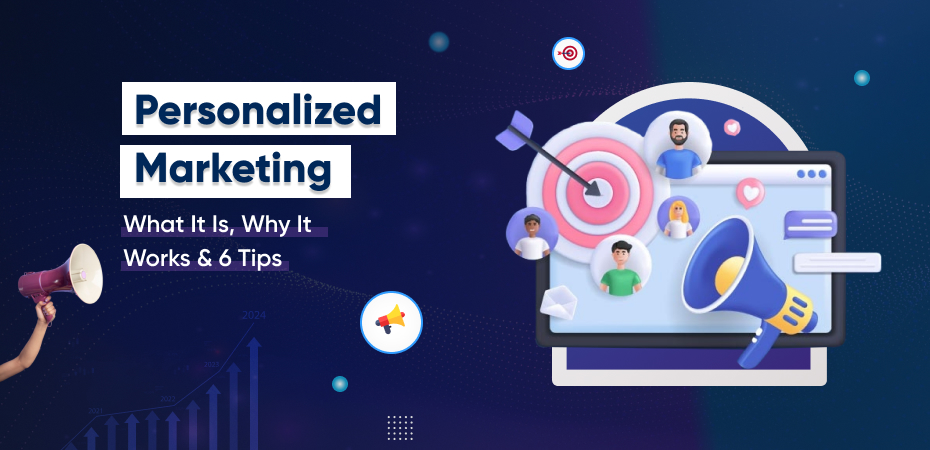Personalized Marketing: What It Is, Why It Works & 6 Tips



Introduction
In today’s crowded digital world, capturing the attention of customers is harder than ever. Generic messages and one-size-fits-all advertising often fall flat. That’s why personalized marketing has become a game-changer for businesses wanting to stand out and connect with their specific audience in a meaningful way.
Personalized marketing means tailoring your marketing messages and offers to meet the unique needs and preferences of individual customers. This approach can drastically improve customer experience, increase engagement, and boost sales.
If you’re curious about what personalized marketing really means, why it’s so effective, and how to use it the right way, this guide is for you. Whether you own a small business or work with a digital marketing agency in New York, learning how to create tailored content can help you connect better with your target audience. It’s also a key part of building a strong and effective marketing plan that brings real results.
Defining Personalized Marketing
Personalized marketing means creating marketing messages and experiences that are tailored to each individual customer. It’s based on things like their behavior, interests, and needs. Instead of sending the same message to everyone, this approach focuses on showing the right message to the right person at the right time.
For example, it could be as simple as using a customer’s name in an email or suggesting products based on what they’ve looked at before. It goes beyond just emails or personalized advertisements—it can also be used on websites, social media, and mobile apps.
To make this work, businesses collect helpful information like purchase history, location, and browsing activity. This data helps create offers and messages that feel more relevant. For instance, a clothing website might show warm jackets to people in cold areas and promote summer clothes to those in warm places.
The main idea behind this approach is to truly understand your audience. When you know what your customers like and need, you can create content and experiences that feel useful and personal—not annoying or overly pushy. Done right, this kind of marketing makes people feel valued, which can lead to better engagement and stronger customer relationships.
Why Personalized Marketing Works
Personalized marketing works because it meets customers where they are and addresses their specific needs. People naturally respond better to messages that feel relevant to them. Here are some reasons why personalized marketing is so effective:
- Relevance Captures Attention: Personalized content is more likely to grab and hold attention because it speaks directly to the interests and needs of the individual.
- Emotional Connection: When customers feel understood, they develop stronger emotional ties to a brand. This loyalty can lead to repeat purchases and brand advocacy.
- Improved Engagement: Customized marketing results in higher open rates, click-through rates, and conversion rates because the message resonates with the audience.
- Better ROI: Personalized marketing campaigns tend to deliver higher returns on investment because they reduce wasted marketing spend and improve efficiency.
- Competitive Advantage: In a crowded market, a well-crafted custom marketing strategy helps businesses stand out by offering unique, tailored experiences.
Many digital marketing agencies in New York now focus heavily on content personalization because it combines creativity with data-driven insights, making marketing both smart and effective.
6 Ways to Do Personalized Marketing Well
Now that you understand the power of personalized marketing, here are six practical tips to help you do it right.
1. Use Customer Data Responsibly and Smartly
Data is the foundation of personalized marketing. Without accurate customer data, you can’t tailor your content effectively. However, it’s crucial to collect and use data ethically, respecting privacy laws like GDPR or CCPA.
Start by gathering basic data such as email addresses, purchase history, and website behavior. Then use analytics tools like Google Analytics, HubSpot, or Segment to analyze patterns and gain insights.
Always be transparent with customers about how you use their data and give them options to control their preferences. Responsible use of data builds trust, which is essential for long-term relationships.
2. Segment Your Audience Effectively
Segmentation means dividing your audience into smaller groups based on shared characteristics such as age, location, interests, or buying behavior. This allows for more precise content personalization.
For example, a fitness brand might segment customers into beginners, advanced users, and athletes, then send different workout tips or product offers to each group.
Effective segmentation ensures your marketing messages are relevant to each group, increasing the chances of engagement. An individualized marketing strategy that includes audience segmentation is much more powerful than broad, generic messaging.
3. Leverage AI and Automation Tools
Artificial intelligence (AI) and automation have transformed personalized marketing by making it scalable. These technologies can analyze vast amounts of data, predict customer preferences, and deliver personalized experiences automatically.
Tools like Dynamic Yield, Optimizely, and Persado help create and test personalized content dynamically on websites and emails. They can recommend products, personalize landing pages, and even tailor offers in real-time based on user behavior.
Automation frees marketers from manual tasks and helps deliver consistent personalized content across channels, which is key to a cohesive custom marketing strategy.
4. Personalize Across Multiple Channels
Today’s customers interact with brands on many social media platforms—email, social media, websites, mobile apps, and more. Personalized marketing works best when it’s consistent across all these channels.
For example, a customer who browses a product on your website should receive an email with related offers or see relevant ads on social media. This cross-channel personalization creates a seamless experience that feels natural and reinforces your message.
A New York based digital marketing agency can help coordinate personalization efforts across channels to ensure your content personalization is cohesive and effective.
5. Create Dynamic and Interactive Content
Static content has its limits. To truly capture attention and drive engagement, dynamic and interactive formats are far more effective. These adapt in real-time based on user actions, creating a more tailored and relevant experience.
Think of tools like product recommendation quizzes, interactive videos that adjust to viewer interests, or smart product suggestions that update as users browse. These features respond to individual preferences, making the experience feel intuitive and valuable.
Interactive elements not only boost engagement but also encourage deeper exploration of your offerings. By making the journey more personal and responsive, you increase the likelihood of conversions and create a lasting impression that keeps users coming back.
6. Continuously Test and Optimize Your Strategy
Personalized marketing isn’t something you set and forget—it’s an ongoing process that thrives on testing and refinement. Regular experimentation helps you understand what resonates most with your audience. Tools like Google Optimize and VWO allow you to run A/B tests on emails, landing pages, and ad variations to see which versions drive better engagement.
Beyond testing, gathering direct customer feedback is key. It reveals how your messages are perceived and whether they feel relevant and helpful. Use this insight to make data-driven adjustments to your approach, ensuring your campaigns stay fresh and effective. Continuous improvement is the secret to long-term success in any custom marketing strategy.
Unique Insights for Smarter Personalized Marketing
To truly differentiate your brand, it’s important to go beyond standard tactics and adopt more advanced strategies that enhance customer experience without overwhelming it. One powerful method is combining tailored messaging with storytelling. Crafting narratives that reflect real customer journeys helps create emotional connections and builds long-term loyalty.
Predictive tools can also give you an edge by anticipating what your audience may need next, allowing you to deliver timely, relevant content that feels intuitive rather than reactive. If your business operates both online and offline, integrating data from both spaces provides a more complete understanding of your audience and helps shape messaging that feels seamless across touchpoints.
However, it’s essential to strike the right balance. When messages feel too specific or automated, they can come off as intrusive. Aim for a natural and helpful tone that respects user boundaries and preferences, ensuring your efforts feel genuinely supportive rather than overly engineered.
Conclusion
Personalized marketing is no longer optional—it’s essential for businesses wanting to thrive in a digital-first world. By tailoring your messages and offers to individual customers, you can create deeper connections, improve engagement, and boost your bottom line.
Building an effective personalized strategy for marketing involves smart use of data, thoughtful segmentation, leveraging the latest AI and automation tools, and delivering consistent content personalization across channels.
Whether you’re managing this in-house or working with a digital marketing agency, a personalized marketing strategy that embraces personalization will give you a significant edge.
If you’re looking for expert help to craft and execute a personalized digital marketing plan tailored to your unique business goals, feel free to explore the services offered by SEO Expert New York—where custom marketing strategies are designed to deliver real results.
Frequently Asked Questions (FAQs)
Personalized marketing focuses on creating unique marketing messages for individual customers based on detailed data, while targeted marketing groups customers into segments and sends the same message to each segment. Personalization is more granular and tailored.
Start small by collecting basic customer data like email and purchase history. Use free or low-cost tools like Mailchimp or Google Analytics for segmentation and simple personalization. Focus on personalized emails and website content before scaling up.
Yes. B2B companies benefit from personalization by tailoring content to different industries, company sizes, or buyer personas. Personalized content helps build trust and shortens sales cycles.
Some popular tools include HubSpot, Dynamic Yield, Optimizely, Google Analytics, and Segment. The right tool depends on your business size, goals, and channels.
Always comply with privacy laws like GDPR and CCPA. Be transparent about data use, obtain consent, and allow customers to manage their preferences. Use secure systems to protect customer data.